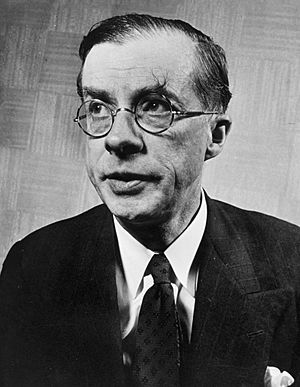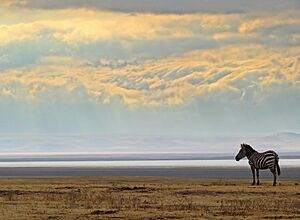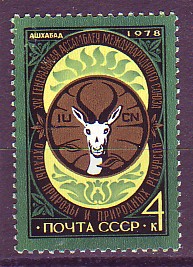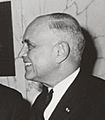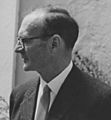International Union for Conservation of Nature facts for kids
 |
|
| Founded | 5 October 1948 Fontainebleau, France |
|---|---|
| Type | International organization |
| Focus | Nature conservation, biodiversity |
| Headquarters | Gland, Switzerland |
|
Area served
|
Worldwide |
|
Members
|
1,400 |
|
Key people
|
|
|
Revenue
|
CHF 140.7 million / US$148 million (2019) |
|
Employees
|
Over 900 (worldwide) |
|
Formerly called
|
International Union for the Protection of Nature |
The International Union for Conservation of Nature (IUCN) is a global group that works to protect nature and use natural resources wisely. It started in 1948. Today, IUCN is a leading expert on the health of our planet and what we need to do to keep it safe.
IUCN gathers and studies information, does research, and runs projects around the world. It also speaks up for nature and helps teach people about conservation. Its main goal is to help societies everywhere protect nature. It also wants to make sure that when we use natural resources, it's fair and doesn't harm the environment in the long run.
Over the years, IUCN has started to focus more on how protecting nature connects with making the world a better place for everyone. This is called "sustainable development." IUCN doesn't usually organize big public campaigns. Instead, it works with governments, businesses, and other groups. It gives them information and advice, and helps them work together. Many people know IUCN best for its IUCN Red List of Threatened Species. This list tells us which plants and animals around the world are in danger of disappearing.
IUCN has over 1,400 member groups. These include governments and non-governmental organizations (NGOs) from more than 170 countries. About 16,000 scientists and experts volunteer their time to help IUCN. The organization also has over 900 full-time staff in more than 50 countries. Its main office is in Gland, Switzerland. Every four years, IUCN holds a big meeting called the IUCN World Conservation Congress. Here, members decide on important goals for protecting nature worldwide.
IUCN works closely with the United Nations. It helps put into action many international agreements about nature and biodiversity (the variety of life on Earth). IUCN also helped start the World Wide Fund for Nature (WWF).
Contents
How IUCN Started
IUCN was created on October 5, 1948, in Fontainebleau, France. Representatives from governments and conservation groups came together. They were encouraged by UNESCO, a part of the United Nations. They signed an agreement to form the International Union for the Protection of Nature (IUPN). The idea for this new group came from Julian Huxley, a British biologist who was the first head of UNESCO.
When it began, IUCN was the only international group that focused on all parts of nature conservation. There was already an international group for birds, but IUCN covered everything.
Early Years: 1948–1965
In its first years, IUCN had 65 members. It worked closely with UNESCO. They even created the first list of species that were in serious danger. For a while, IUCN mostly relied on money from UNESCO. When that funding stopped in 1954, IUCN had to slow down its work.
IUCN was good at getting smart scientists involved and finding important problems. For example, it pointed out how harmful pesticides were to wildlife. But many of its ideas didn't turn into real action. This was because governments weren't ready to act, and IUCN didn't have enough money or a clear role yet. In 1956, IUCN changed its name to the International Union for Conservation of Nature and Natural Resources.
During this time, IUCN started working more with other UN groups. It also began publishing its famous Red Data Book in 1964. This book lists the conservation status of different species.
IUCN also started helping create international agreements. The first one was the African Convention on the Conservation of Nature and Natural Resources.
Many of IUCN's early projects focused on Africa. IUCN supported the idea of "protected areas" like national parks. In these areas, human activity was limited to protect nature.
To get more stable funding, IUCN helped set up the World Wildlife Fund (WWF) in 1961. WWF's job was to raise money to help cover IUCN's costs. Also in 1961, IUCN moved its main office from Belgium to Morges in Switzerland.
Growing Influence: 1966–1985
In the 1960s, IUCN worked to get a special status for non-governmental organizations (NGOs) at the UN. In 1968, the UN agreed to give NGOs "consultative" status. This meant they could give advice to the UN. IUCN itself gained this status with six UN organizations.
IUCN was one of the few environmental groups involved in preparing for the United Nations Conference on the Human Environment in Stockholm in 1972. This conference led to three important international agreements that IUCN helped create and put into action:
- Convention Concerning the Protection of World Cultural and Natural Heritage (1972): IUCN helped write this and still advises UNESCO on natural World Heritage sites.
- CITES – the Convention on International Trade in Endangered Species of Wild Fauna and Flora (1974): IUCN was involved in this agreement, which controls the trade of endangered plants and animals.
- Ramsar Convention – Convention on Wetlands of International Importance (1975): This agreement protects important wetlands. IUCN still manages its main office.
IUCN also made a deal with the United Nations Environment Programme (UNEP). This deal meant IUCN would regularly check on conservation efforts worldwide. The money from this, plus growing funds from WWF, finally gave IUCN a stable financial base.
During this time, IUCN slowly changed its approach. It started trying to work more with developing countries.
In 1975, IUCN began working on the World Conservation Strategy, which came out in 1980. This project helped IUCN realize that simply banning people from natural areas wasn't always the best way to protect nature. They understood that people needed to be part of the solution. In 1982, the United Nations General Assembly adopted the World Charter for Nature, which IUCN had helped prepare.
In 1980, IUCN and WWF moved into shared offices in Gland, Switzerland. This showed how closely they worked together. However, in 1985, WWF decided to manage its own projects, which had been run by IUCN. This made their ties less close.
Sustainable Development and Global Reach: 1985 to Today
In 1982, IUCN created a special center to help make sure nature conservation was part of development aid and economic plans in developing countries. This center helped 30 countries create their own conservation plans. Many European countries started sending money for aid projects through IUCN. IUCN staff managed these projects, often from new offices set up around the world. This meant IUCN's staff and regional offices became more important.
In 1991, IUCN, along with UNEP and WWF, published Caring for the Earth. This was a follow-up to the World Conservation Strategy.
IUCN also started including social issues in its work. In 1994, IUCN changed its mission statement to include using natural resources in a fair and environmentally sound way.
Working with Businesses
Since 2000, IUCN has worked more closely with businesses. Its members decided that engaging with businesses was important to protect nature. IUCN has partnered with groups like the World Business Council for Sustainable Development.
In 2003, IUCN started its Global Business and Biodiversity Program (BBP). This program helps and guides private companies to deal with environmental and social issues. A big part of this program was a five-year partnership IUCN began with the energy company Shell International in 2007.
Today, the Business and Biodiversity Programme helps guide IUCN's overall approach to working with businesses. It makes sure that IUCN's plan for working with businesses is put into action through its global and regional programs.
Championing Nature-based Solutions
Since 2009, IUCN has strongly supported "Nature-based Solutions" (NbS). These solutions use natural systems and the benefits they provide to solve big problems like climate change, food shortages, or natural disasters. For example, instead of building a big concrete wall to stop floods, a nature-based solution might be to restore coastal wetlands.
At the IUCN World Conservation Congress in 2016, IUCN members agreed on a clear definition for nature-based solutions. They also asked governments to include these solutions in their plans to fight climate change.
Timeline of Key Events
Here are some important dates in IUCN's history:
- 1948: The International Union for the Protection of Nature (IUPN) is created.
- 1956: The name changes to the International Union for the Conservation of Nature and Natural Resources (IUCN).
- 1959: The UN asks IUCN to prepare a list of international nature parks and reserves.
- 1961: The World Wide Fund for Nature (WWF) is set up to help raise money and public support for conservation.
- 1969: IUCN gets a grant from the Ford Foundation, which helps its international office grow.
- 1972: UNESCO adopts the Convention Concerning the Protection of World Cultural and Natural Heritage. IUCN provides expert advice for this.
- 1974: IUCN helps its members agree to sign the Convention on International Trade in Endangered Species of Wild Fauna and Flora (CITES).
- 1975: The Convention on Wetlands of International Importance (Ramsar Convention) begins. IUCN manages its main office.
- 1980: IUCN, along with United Nations Environment Programme and World Wide Fund for Nature, works with UNESCO to publish a World Conservation Strategy.
- 1982: The United Nations General Assembly adopts the World Charter for Nature, after IUCN helped prepare it.
- 1990: IUCN starts using the name World Conservation Union as its official name, but still uses IUCN as its short form.
- 1991: IUCN, along with United Nations Environment Programme and World Wide Fund for Nature, publishes Caring for the Earth.
- 2003: The IUCN Business and Biodiversity Program is created.
- 2008: IUCN stops using World Conservation Union and goes back to its original name, International Union for Conservation of Nature.
- 2012: IUCN publishes a list of The world's 100 most threatened species.
- 2016: IUCN creates a new membership type for groups representing indigenous peoples.
What IUCN Does Today
IUCN works on many important topics. These include business, climate change, how nature affects money, ecosystems, environmental law, forest conservation, how gender affects conservation, global rules, oceans and polar areas, protected areas, science, social policy, species, water, and world heritage.
IUCN plans its work in four-year programs. These programs are decided by its members. The current program (2017–2020) connects protecting nature and biodiversity with sustainable development and reducing poverty. IUCN says its work is based on strong facts. It also values the knowledge of indigenous groups and others who have traditionally used natural resources.
The IUCN Programme 2017–2020 has three main goals:
- Valuing and protecting nature.
- Making sure natural resources are managed fairly and effectively.
- Using Nature Based Solutions to solve big problems like climate change, food shortages, and economic and social development.
IUCN doesn't usually try to get the general public involved directly. Education has always been part of IUCN's work. But it focuses more on working with specific groups and sharing information, rather than big public campaigns.
Protecting Habitats and Species
IUCN runs projects around the world to protect habitats and species. It creates the IUCN Red List of Threatened Species. This list tells us which animals and plants are in danger. It also creates the IUCN Red List of Ecosystems, which can be used for local, national, regional, and global areas.
IUCN's goal is to grow the worldwide network of national parks and other protected areas. It also wants to make sure these areas are managed well. It especially focuses on better protection for the oceans and marine habitats.
Working with Businesses
IUCN has a growing number of partnerships with companies at local, national, and international levels. These partnerships help promote using natural resources in a way that can continue for a long time without harming the environment.
Influencing Policy
At the national level, IUCN helps governments create their own plans for protecting biodiversity. On the international level, IUCN gives advice to important environmental agreements. These include the Convention on Biological Diversity, CITES, and the Framework Convention on Climate Change. It also advises UNESCO on natural world heritage sites.
IUCN has a special team that works permanently at the United Nations. It also has official connections with many other international groups.
How IUCN is Organized
IUCN has three main parts: its member organizations, its seven groups of scientific experts called commissions, and its main office staff (the secretariat).
Members
IUCN's members include countries, government groups, international non-governmental organizations, national non-governmental organizations, and groups representing indigenous peoples. In 2017, IUCN had 1400 members. These members can form national or regional committees to work together. In 2016, there were 62 national committees and 7 regional committees.
Commissions
The seven IUCN Commissions are made up of volunteer experts from many different fields. They study the state of the world's natural resources. They also give IUCN good advice and ideas on how to deal with conservation issues.
- Commission on Education and Communication (CEC): This group focuses on how IUCN and other conservation groups share information, learn, and manage knowledge.
- Commission on Environmental, Economic and Social Policy (CEESP): This group looks at how money and society affect the protection and wise use of nature.
- World Commission on Environmental Law (WCEL): This group creates new legal ideas and tools. It also helps societies use environmental laws for conservation and sustainable development.
- Commission on Ecosystem Management (CEM): This group focuses on managing natural and changed ecosystems in a complete way.
- Species Survival Commission (SSC): This group deals with the technical side of protecting species. It also takes action for species that are in danger of extinction. Its expert groups create plans to help endangered species recover.
- World Commission on Protected Areas (WCPA): This group works to create and manage a good network of protected areas on land and in the ocean.
- Climate Crisis Commission: This commission was started in 2021.
IUCN's main office is in Gland, Switzerland. It also has eight regional offices, each led by a director. These offices carry out IUCN's programs in their areas. Since 1980, IUCN has opened offices in more than 50 countries.
How IUCN is Run and Funded
Governance
The World Conservation Congress is IUCN's most important decision-making meeting. It happens every four years. At this meeting, members elect the council, including the president. They also approve IUCN's work plan and budget for the next four years.
The IUCN council is the main group that guides IUCN. It sets the direction for IUCN's activities, discusses important policy issues, and gives advice on money and membership. The council includes the president, four vice presidents, the treasurer, the heads of IUCN's six commissions, three regional members from each of IUCN's eight regions, and a member from Switzerland (where IUCN is based). The current IUCN president is Razan Al Mubarak.
The council chooses a director general. This person is in charge of managing IUCN overall and running its main office. The current IUCN director general is Bruno Oberle.
- IUCN Presidents since 1948
- 1948–1954
 Charles Jean Bernard
Charles Jean Bernard - 1954–1958
 Roger Heim
Roger Heim - 1958–1963
 Jean Georges Baer
Jean Georges Baer - 1963–1966
 François Bourlière
François Bourlière - 1966–1972
 Harold J. Coolidge
Harold J. Coolidge - 1972–1978
 Donald Kuenen
Donald Kuenen - 1978–1984
 Mohamed Kassas
Mohamed Kassas - 1984–1990
 M. S. Swaminathan
M. S. Swaminathan - 1990–1994
 Shridath Ramphal
Shridath Ramphal - 1994–1996
 Jay D. Hair
Jay D. Hair - 1996–2004
 Yolanda Kakabadse
Yolanda Kakabadse - 2004–2008
 Valli Moosa
Valli Moosa - 2008–2012
 Ashok Khosla
Ashok Khosla - 2012–2021
 Zhang Xinsheng
Zhang Xinsheng - 2021–present
 Razan Al Mubarak
Razan Al Mubarak
- IUCN Directors General since 1948
- 1948–1955
 Jean Paul Harroy
Jean Paul Harroy - 1955–1958
 Tracy Philipps
Tracy Philipps - 1959–1960
 M.C. Bloemers
M.C. Bloemers - 1961–1962
 Gerald Watterson
Gerald Watterson - 1963–1966
 Hugh Elliott
Hugh Elliott - 1966–1970
 Joe Berwick
Joe Berwick - 1970–1976
 Gerardo Budowski
Gerardo Budowski - 1977–1980
 David Munro
David Munro - 1980–1982
 Lee M. Talbot
Lee M. Talbot - 1983–1988
 Kenton Miller
Kenton Miller - 1988–1994
 Martin Holdgate
Martin Holdgate - 1994–1999
 David McDowell
David McDowell - 1999–2001
 Marita Koch-Weser
Marita Koch-Weser - 2001–2006

 Achim Steiner
Achim Steiner - 2007–2014
 Julia Marton-Lefèvre
Julia Marton-Lefèvre - 2015–2019
 Inger Andersen
Inger Andersen - 2019–present
 Bruno Oberle
Bruno Oberle
Funding
In 2012, IUCN's total income was about 114 million Swiss francs (around 116 million US dollars).
Most of IUCN's money (61% in 2012) comes from official aid budgets given by different countries and international groups. Other money comes from membership fees, as well as grants and project funding from foundations, other organizations, and companies.
See also
 In Spanish: Unión Internacional para la Conservación de la Naturaleza para niños
In Spanish: Unión Internacional para la Conservación de la Naturaleza para niños
- List of environmental organizations
- List of conservation organisations


